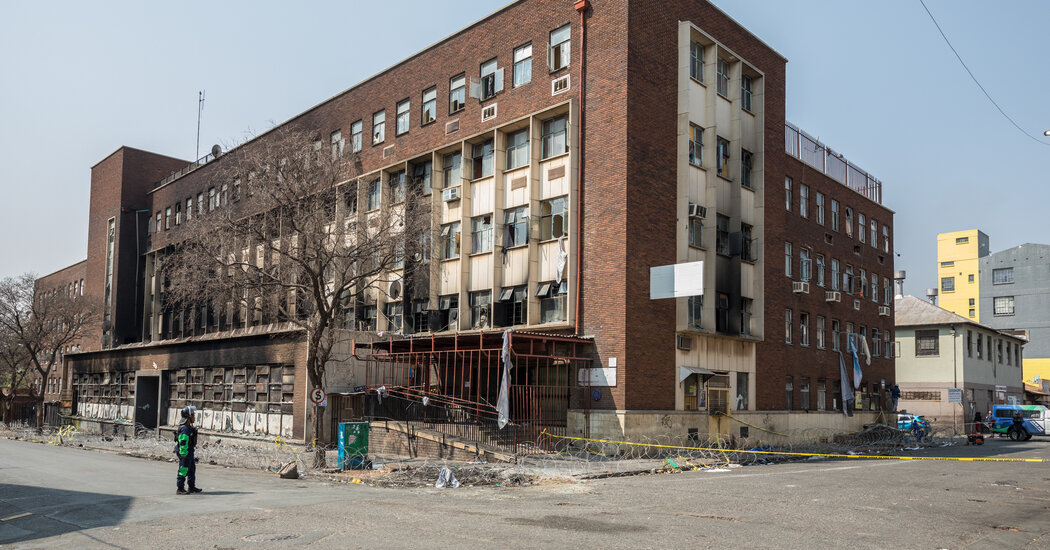It was time, the witness said, to tell the whole truth about the awful things he had done.
Moments before testifying this week at an inquiry into one of South Africa’s deadliest residential fires, he pulled an investigator aside and said he needed to change his story. He was the one, he said, who had started the Aug. 31 blaze that engulfed a five-story building in downtown Johannesburg.
Sobbing as he spoke, Sithembiso Mdlalose, 30, told a room full of stunned listeners that he had strangled a man on the ground floor of the overcrowded, derelict dwelling and set the body alight.
After that confession at the inquiry, Mr. Mdlalose was arrested by the police, who are running a parallel criminal investigation into the fire, and charged with 76 counts of murder. But as he made his first criminal court appearance on Thursday, there remained plenty of confusion and mystery around this shocking twist in a tragedy that has attracted international attention to the awful living conditions of thousands of people in buildings across one of Africa’s wealthiest cities.
While Mr. Mdlalose’s confession at the inquiry is inadmissible, prosecutors said, his confession will bolster the criminal investigation.
Mr. Mdlalose, who said he lived in the building, seemed to appear out of the blue to the lawyers and activists working with some of the building’s former residents, many of whom largely said they did not know him. He was one of many witnesses set to speak at the inquiry, which began in October.
Before his appearance at the inquiry, he gave a handwritten statement to the police that stopped far short of what he ultimately admitted to. In his statement, obtained by The New York Times, Mr. Mdlalose confessed that he was one of the many criminals who sold drugs in the building, but suggested that others had killed the initial victim and set him on fire.
Mr. Mdlalose gave that statement to the police about a month ago. A spokeswoman with the South African Police Service declined to comment when asked why he had not been arrested sooner.
Some victims’ advocates fear that Mr. Mdlalose’s bombshell testimony this week could obscure the broader failures that led to the fire, which the inquiry is meant to expose. Testimony so far has revealed that the illegally occupied building, which is owned by the city, was riddled with fire hazards that officials failed to address, said Nigel Branken, an immigrant rights activist who is working with survivors of the fire.
“The concern I have is that the city says, ‘Aw great, we’ve got somebody,’ and they can take away from their obligations,” Mr. Branken said.
“The city is culpable for more of the deaths than the guy who started the fire,” he added.
Mlimandlela Ndamase, a spokesman for the mayor of Johannesburg, urged caution before rushing to judgment.
“Let’s wait for the investigation to conclude and then we’ll understand what responsibility or liability is placed upon whom,” he said.
This week, guilt and fear drove Mr. Mdlalose to confess that he had set the fire, according to Nomzamo Zondo, executive director of the Socio-Economic Rights Institute, who was present at the inquiry hearing. Another person who was there but was not authorized to comment said that Mr. Mdlalose had pulled aside one of the people in charge of presenting evidence and said that he wanted to tell the truth.
Mr. Mdlalose, whose age the police gave earlier this week as 29, spoke to the inquiry behind closed doors out of fear that the criminals who operated in the building would kill him, but lawyers and activists who were in the room recounted his story afterward.
He testified that he had been working for a drug dealer when he was called in to rough up a man who had gotten into a dispute with the dealer, the observers said. Mr. Mdlalose, who said he was high on methamphetamine at the time, said he found the man already tied up, with a bag over his head, in a room in the building.
He beat the man until he was unconscious and bloody, and only when he removed the bag did he recognize the man, he said. Panicked that he would be identified if the man survived, he told the inquiry, he strangled him with his bare hands, then doused the body with gasoline and set the room alight to hide his crime.
In his previous written statement to the police, Mr. Mdlalose admitted to beating the man along with others. He said in that statement that the man, who was left slumped in a chair, died from his injuries. He and his accomplices poured gasoline on the man’s body and around the room, but left without setting it on fire, the statement said.
At the public inquiry, Mr. Mdlalose said he had decided to come clean when someone who saw him carrying the gasoline into the building persuaded him to hand himself over. That witness testified at the inquiry a day earlier.
In court on Thursday as a criminal defendant, wearing a faded khaki parka with lint in his hair, Mr. Mdlalose barely spoke over a whisper as a magistrate explained the long prison sentence he now faced for multiple counts of murder, attempted murder and arson.
Phindi Mjonondwane, a spokeswoman for the prosecution, said that prosecutors were open to a plea deal.
For his own safety, Mr. Mdlalose will remain in a private cell, his defense attorney, Dumisani Mabunda, said. The investigation could take years, he warned, adding that his client was willing to cooperate with the police.
